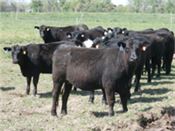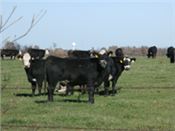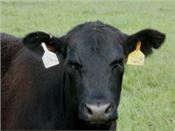|
Show-Me-Select Heifer Program Has Stood Test Of Time By Teaching Producers Genetics And Increasing Their Profits

A set of Tier Two heifers
Photo credit: MU Extension
MT. VERNON, MO.
Shortly after the recent Missouri Show-Me-Select Bred Heifer Sale in southwest Missouri, a newcomer to the program, asked Eldon Cole, a livestock specialist with University of Missouri Extension a question. "What can I do to improve my SMS heifers?"
“I suspect his question is not unique to him. I’d like to think that any participant in this value-added program for beef cattle aspires to improve the heifers they offer for sale,” said Cole.
When the Show-Me-Select effort began in 1996 three objectives were set forth. They were: implement a Total Quality Management strategy to on-farm heifer development; enhance marketing opportunities for and add value to Missouri-raised heifers; provide a reliable source of quality replacements based on management, reproduction and genetics.
Nineteen years later those objectives or goals still apply.
“The methods of reaching those goals have been upgraded as technology entered the picture. For instance, artificial insemination, heat synchronization, and fixed-time or appointment breeding are now used in a majority of SMS heifers. I feel most consignors realize that AI is critical to attracting buyers, and it will only expand,” said Cole.
Cole credits the SMS program with a greater understanding and acceptance of expected progeny differences (EPD).
“In the early years of EPDs, cattlemen were skeptical that these numbers did not work or could be manipulated. Little by little, the SMS calving ease direct and birth weight EPD standards – which were required for a bull to qualify as a service sire – began to open people’s eyes. Folks saw the merit of them for calving ease and decided if they work for that trait, they might be a good predictor of growth, daughters' milk production, carcass traits, profitability, and temperament.”
Cole notes that SMS participants have seen a lot of needed genetic improvement and, perhaps equally important, have added the genomics to their vocabulary. Today, progressive SMS person use genomics to advance the heifers to the Show-Me-Plus classification.
“This is done via hair or blood sampling to get a better picture of the heifers’ genetic makeup. In addition to the heifers own genomic profile, the service sire should have his EPDs enhanced with the DNA test. This improves his EPD accuracy to appear he is already had from 10 to 24 progeny recorded through his association's program," said Cole. "These tools help operations keep pace with the technology trends that go with the program. You can either do the bare minimum or step-out and try such items as fetal sexing or genomic predictions.”
At the end of the day, most participants measure their improvement by the money after the sale. Cole says a simple way to do that is to divide your heifer’s average price by the average of the heifers in the sale and multiply that by 100. The answer is a ratio with 100 being average, just like a weaning weight ratio.
“If you get over 100, that indicates you are better than the average on heifer price in the sale,” said Cole. “However, if you consistently find your ratio is much below 100, there’s work to do.”
Besides the above genetic and economic efforts, most SMS participants also work to improve their reputation via marketing and customer attention before and after the sale.
Cole says commercial cow-calf producers do have to adapt to marketing breeding stock as they embark on the SMS program. Purebred breeders are used to promoting their cattle while the commercial person must sharpen their salesmanship.
“The Show-Me-Select heifer program has stood the test of time. New participants can use technology as it comes through research to improve the heifers they are producing,” said Cole.
The next round of sales in the SMS program will be in May when fall-calvers will be sold. ∆

Home raised or purchased
Photos credit: MU Extension

SimAngus Heifer with Tier Two tags
|
|